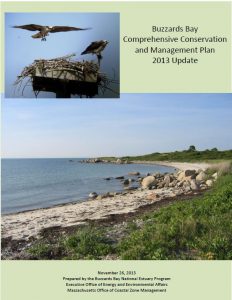2013 CCMP, Chapter 5:
Implementing the Buzzards Bay CCMP
About the new Buzzards Bay CCMP Action Plans
The Buzzards Bay Comprehensive Conservation and Management Plan (CCMP) was updated in November 2013 to reflect the great progress achieved since the original CCMP was finalized.
This page has only a few highlights of this chapter.
Read the actual text of Chapter 5 as a pdf file (200 kb), with graphics.
Implementing the Buzzards Bay CCMP
[This web page just has a few opening paragraphs. Open the pdf file above for the entire chapter.]
The Players and Their Roles
Buzzards Bay remains an estuary in transition, subject to stresses from new development, yet benefiting from ongoing restoration efforts. Increased development along its shores, coupled with decades of dumping industrial and municipal wastes into its waters, created the initial call to restore and protect the bay. Evolving regulatory and nonregulatory approaches in environmental management can provide the formula for renewal.
The action plans presented in Chapter 4 include a number of stated commitments and other recommended steps that government must take, now and in the future, to preserve and protect Buzzards Bay. The action plans also identify the organizations that are responsible for taking those steps. These organizations include regulatory and planning agencies at the federal, state, regional, and local level, legislative bodies, and citizens groups. Table 41 shows which organization is primarily responsible for each of the recommendations in the action plans. This chapter provides a broader perspective of the role of each of organization involved in implementing these recommendations and in undertaking the future work needed to ensure that complete implementation occurs within a reasonable time. For many of the recommendations, these organizations share overlapping responsibilities, and close coordination is required to ensure each responsible entity takes action. For other recommendations, a single organization can achieve the desired result. For still others, the implementing responsibility may belong to one organization, but another may be able to provide technical or financial assistance.
Federal and state regulatory agencies, such as the U.S. Environmental Protection Agency (EPA) and Massachusetts Department of Environmental Protection (DEP), have authorities that can address many of the recommendations contained in the action plans. However, the major focus of this CCMP and the Buzzards Bay NEP as a whole has been on compelling local authorities to take action to preserve the bay and its resources because, in the New England tradition of home rule, such management decisions belong to the community and its inhabitants. The theme has been increasingly codified by state and federal agencies in efforts to aggregate traditional nonpoint source pollution sources into traditional pointsource pollution programs. This is particularly evident in the Phase II MS4 stormwater permits now required of municipal governments and other entities.
The Commonwealth has an additional responsibility created by the fact that it owns, on behalf of the public, all rights in tidal waterways beyond the low water mark, for public access, and an easement in the intertidal zone for fishing, fowling, and navigation. These rights are held “in trust” for the benefit of the public. This responsibility of stewardship of these public trust lands and protecting the integrity of the Buzzards Bay ecosystem, is reflected in this management plan, and in other documents, like the 2009 Massachusetts Ocean Plan.
